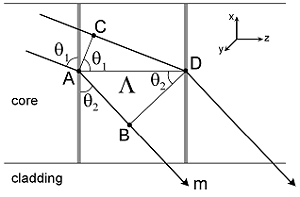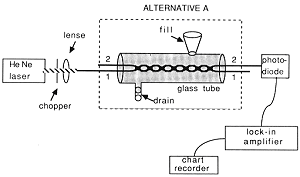|
LPBG | Twisted Pair
 This work was done by Pey-Schuan Jian A long period Bragg grating (LPG) has a grating written into the core in the form of a periodic change in refractive index, where the period of that grating is on the order of 100 µm. Due to this periodic perturbation, LPGs couple light from core modes into cladding modes, and that coupling is sensitive to the refractive index of the environment around the fiber. (The jacket is removed, so that the cladding is exposed directly to the surrounding environment.) Changes in the index of refraction of the ambient change the wavelengths that are coupled, and thus shift the position of the attenuation peak. We have developed a model to guide the design of such sensors, and there is good agreement of this model with experiment. Such gratings can be highly sensitive sensors for changes in index. This work was done by Pey-Schuan Jian A long period Bragg grating (LPG) has a grating written into the core in the form of a periodic change in refractive index, where the period of that grating is on the order of 100 µm. Due to this periodic perturbation, LPGs couple light from core modes into cladding modes, and that coupling is sensitive to the refractive index of the environment around the fiber. (The jacket is removed, so that the cladding is exposed directly to the surrounding environment.) Changes in the index of refraction of the ambient change the wavelengths that are coupled, and thus shift the position of the attenuation peak. We have developed a model to guide the design of such sensors, and there is good agreement of this model with experiment. Such gratings can be highly sensitive sensors for changes in index.
Figure above is from P.-S. Jian and E. Smela, "Modeling the performance of a long-period Bragg grating ambient-index sensor," Smart Mater. Struct., 15, 821-828 (2006).
For further information, see:
P.-S. Jian and E. Smela, "Modeling the performance of a long-period Bragg grating ambient-index sensor," Smart Mater. Struct., 15, 821-828 (2006).
 If a pair of optical fibers is twisted around each other, then guided modes of light in the first fiber are converted into radiating modes that interact with the surrounding medium. Some of that light enters the second fiber and is converted to guided modes that can be detected. (The number and tightness of the twists can be optimized.) Since the environment modulates the light transfer, the twisted pair can be used as a sensor: changes in refractive index, absorption, and scattering change the intensity of the signal. One example experimental configuration is shown here. If a pair of optical fibers is twisted around each other, then guided modes of light in the first fiber are converted into radiating modes that interact with the surrounding medium. Some of that light enters the second fiber and is converted to guided modes that can be detected. (The number and tightness of the twists can be optimized.) Since the environment modulates the light transfer, the twisted pair can be used as a sensor: changes in refractive index, absorption, and scattering change the intensity of the signal. One example experimental configuration is shown here.
Figure above is from E. Smela and J. J. Santiago-Aviles, "A versatile twisted fiber optic sensor," Sens. Act., 13 (2), 117-129 (1988).
The light signal is linearly related to the refractive index of the fluid surrounding the twisted pair. Even more interesting, however, is that each fluid has a characteristic “signature” over time as it evaporates from the fibers.
For further information, see:
E. Smela and J. J. Santiago-Aviles, "A versatile twisted fiber optic sensor," Sens. Act., 13 (2), 117-129 (1988).
E. Smela and J. J. Santiago-Aviles, "A versatile twisted fiber optic sensor," The Electrochemical Society Fall Meeting, Honolulu, Hawaii, vol. 87-2, p. 2300 (Oct. 18-23, 1987).
|
|
Research Home
Research Labs
Research Links
|
 This work was done by
This work was done by  If a pair of optical fibers is twisted around each other, then guided modes of light in the first fiber are converted into radiating modes that interact with the surrounding medium. Some of that light enters the second fiber and is converted to guided modes that can be detected. (The number and tightness of the twists can be optimized.) Since the environment modulates the light transfer, the twisted pair can be used as a sensor: changes in refractive index, absorption, and scattering change the intensity of the signal. One example experimental configuration is shown here.
If a pair of optical fibers is twisted around each other, then guided modes of light in the first fiber are converted into radiating modes that interact with the surrounding medium. Some of that light enters the second fiber and is converted to guided modes that can be detected. (The number and tightness of the twists can be optimized.) Since the environment modulates the light transfer, the twisted pair can be used as a sensor: changes in refractive index, absorption, and scattering change the intensity of the signal. One example experimental configuration is shown here.